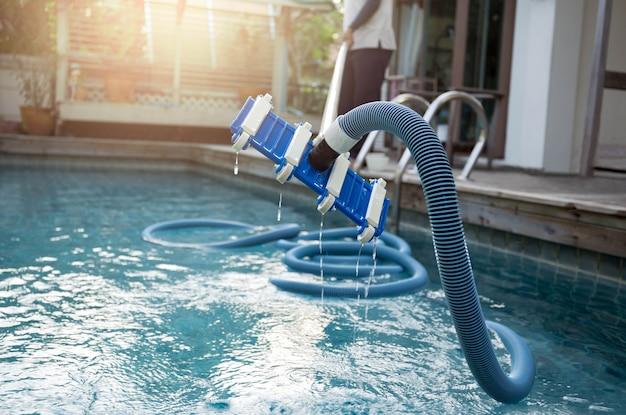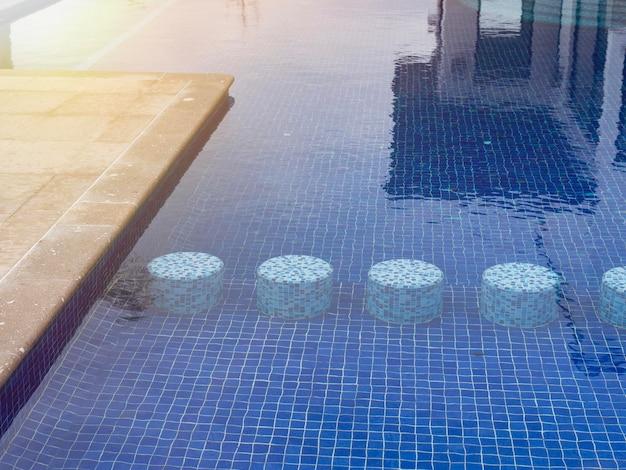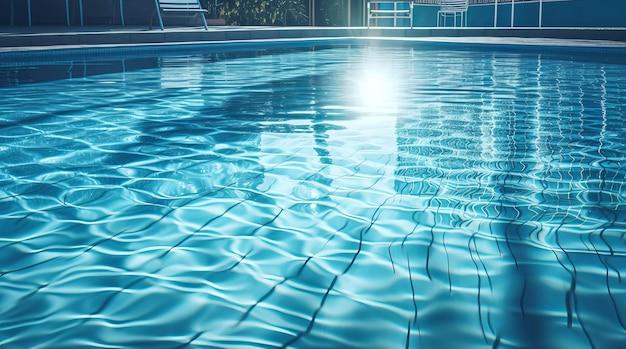Are you tired of the worn-out surface of your swimming pool? Resurfacing your pool might be the best solution. A new surface will not only give your pool a fresh and attractive look, but it can also improve its functionality and safety. However, resurfacing your pool can be a daunting task, especially if you don’t know where to start. Don’t worry, though. In this blog post, we’ll provide you with step-by-step instructions on how to resurface a pool yourself. We’ll also discuss the pool resurfacing cost calculator, how to prepare your pool for resurfacing, the best pool resurfacing material, and the difference between replastering and pool resurfacing. Let’s dive in!
How to Resurface a Swimming Pool
Is your swimming pool beginning to show signs of wear and tear? Does it look like it’s been through a hurricane? Fear not, my friend, because you’re about to learn how to resurface your swimming pool like a pro. Resurfacing your swimming pool can be a daunting task, especially if you’re not familiar with the process. But hey, don’t worry, I’ve got your back, and we’ll go through this together.
Check for Damage
The first thing you should do before resurfacing your pool is to check for any damages in the pool surface. To do so, you can run your hand over the surface and feel for any rough patches. If you find any, don’t panic — it’s entirely normal. However, if you find cracks bigger than 1/8 inch or any gaps in the pool surface, this may require professional assistance.
Choose a Date
Select a date to begin resurfacing your pool that isn’t in your peak swimming season. It is best to avoid the hot months and choose a cooler part of the year, like early spring or late fall, depending on your climate zone. If you plan to use an epoxy-based sealant for your resurfacing, the temperature should be between 50°F and 90°F. Otherwise, high temperatures may cause the sealant to dry prematurely, leading to poor results.
Prep the Surface
Once you have checked for any damages and decided on a date, the next step is to prepare the pool surface. Begin by draining all the water from the pool, and clean the surface of debris and materials. Scrub the surface with a rough brush or pressure washer to ensure all the old finish has been removed. After you’ve finished cleaning, wipe the surface with a clean towel to ensure it’s dry before proceeding.
Prime the Surface
Before applying any new finish or color, you need to prime the surface. Priming the surface is essential because it promotes better bonding with the new finish, creating a strong seal. You can use a bonding or an etching primer, and follow the manufacturer’s instructions for applying the primer. This will be the key step in ensuring your pool surface is as smooth and resilient as possible.
Apply the Finish
Now that you’ve prepared the surface and primed it, it’s time to apply the new finish! You can use any type of coating material suitable for swimming pools like plaster, aggregate, or fiberglass. Ensure that the finish is applied evenly and smoothly, and follow the manufacturer’s instructions carefully.
Fill and Enjoy
After the finish has cured, you can fill up your pool and enjoy it. Ensure you follow the manufacturer’s instructions on the curing time. Additionally, it is essential to keep the water chemistry balanced because improper water chemistry can cause staining and damage to the new pool surface.
Congratulations! You have successfully resurfaced your swimming pool! Remember to take adequate care of your pool to ensure it maintains its shine and sturdiness.
How to Resurface a Pool Yourself
So, you’ve got a pool that’s looking a bit worse for wear, and you’ve decided to take matters into your own hands. Whether you’re a seasoned DIYer or a complete novice, resurfacing a pool can be a daunting task. But fear not, because with the right tools and a bit of know-how, you can have your pool looking brand spanking new in no time!
Step 1: Drain the Pool
The first step to resurfacing your pool is to drain all the water out of it. This might seem obvious, but you’d be surprised how many people forget this step and end up making a huge mess. Once the pool is drained, give it a good clean to remove any debris or algae that might have accumulated on the bottom and sides.
Step 2: Prepare the Surface
Now that your pool is empty and clean, it’s time to prepare the surface for resurfacing. This means removing any loose or damaged plaster from the pool walls and floor. Once that’s done, you’ll need to give the surface a good sanding to create a rough texture that the new plaster can adhere to.
Step 3: Mix the Plaster
Now for the fun part: mixing the plaster. This is where things can get a bit tricky, so make sure you follow the instructions carefully. You’ll need to mix the plaster with water until it reaches a smooth, creamy consistency. Depending on the type of plaster you’re using, you may need to add other ingredients like sand or bonding agents.
Step 4: Apply the Plaster
With your plaster mixed and ready to go, it’s time to start applying it to the pool surface. This can be a bit of a workout, so make sure you take regular breaks to avoid fatigue. Use a trowel to apply the plaster to the walls and floor of the pool, making sure you create an even layer.
Step 5: Smooth and Cure the Plaster
Once the plaster is applied, it’s time to smooth it out and let it cure. This again requires a bit of patience and regular attention. You’ll need to use a pool trowel to smooth out any bumps or ridges in the plaster, and then let it dry for at least 24 hours. After that, you can fill up the pool again and enjoy your newly resurfaced paradise!
Resurfacing a pool yourself can be a challenging and rewarding project. With the right tools and preparation, anyone can do it! So, grab your trowel and get ready to make a splash!
Pool Resurfacing Cost Calculator
You’ve decided it’s time to give your pool a facelift, but now you’re left with the question: how much is this going to cost? Calculating the cost of pool resurfacing can be a daunting task, but luckily, there are helpful tools available to save you from the headache.
What is a Pool Resurfacing Cost Calculator
A pool resurfacing cost calculator is an online tool that helps you estimate the cost of resurfacing your pool. It takes into account factors such as the type of material used, the size of the pool, and the labor required. By providing some simple inputs, the calculator will give you an accurate estimate of how much it will cost to resurface your pool.
How to Use a Pool Resurfacing Cost Calculator
Using a pool resurfacing cost calculator is simple and straightforward. First, you’ll need to find a reputable calculator online. Then, enter all the required information such as pool size, pool type, and the type of material you want to use. The calculator will then give you an instant estimate of the cost. Keep in mind that this is just an estimate, and the actual cost may vary.
Factors That Affect the Cost of Pool Resurfacing
Several factors can affect the cost of pool resurfacing. These include:
- Pool size
- Type of pool
- Type of material used for resurfacing
- Labor costs
- Any additional repairs needed
It’s important to take all of these factors into account when using a pool resurfacing cost calculator to ensure accuracy.
Tips for Saving Costs on Pool Resurfacing
Resurfacing your pool can be an expensive endeavor, but there are ways to save costs. Here are some tips:
- Do some of the work yourself
- Choose a more affordable resurfacing material
- Shop around for contractors and compare prices
- Schedule the work during the offseason when contractors may offer discounted rates
A pool resurfacing cost calculator can be a lifesaver when it comes to estimating the cost of pool resurfacing. By taking into account all the factors that affect the cost, you can ensure that you get an accurate estimate of what you can expect to pay. Whether you’re looking to save costs or just want to know what you’re getting into, using a pool resurfacing cost calculator is a smart decision.
How to Prepare Your Pool for Resurfacing
Before diving into the resurfacing process, you need to prepare your pool adequately. Here’s what you need to do:
Drain the Pool
The first and most crucial step in preparing your pool for resurfacing is draining the pool. You cannot resurface a pool with water in it. However, don’t just drain the pool; you need to do it correctly. Follow all the recommended guidelines to ensure that you don’t damage the pool structure.
Clean the Pool
Once you’ve drained the pool, the next step is to clean it thoroughly. Remove all the debris and dirt that may be lying at the bottom or the sides of the pool. Don’t forget to scrub the tile line and remove any algae or mold that may have accumulated.
Inspect the Pool
Before resurfacing the pool, you need to inspect it for any leaks or potential structural damage. Check for any cracks or chips on the pool’s walls or floor, and ensure they are repaired before resurfacing.
Hire a Professional
Resurfacing your pool is not a DIY project. It would be best to hire a professional pool resurfacing company to handle the project. They have the right tools and experience to prepare the pool correctly and complete the resurfacing project successfully.
By following these steps, you can prepare your pool adequately for resurfacing. Ensuring your pool is ready before resurfacing can help avoid any damage or additional costs down the road.
What’s the Best Material for Swimming Pool Resurfacing
Are you tired of looking at your old and outdated pool? Do you have chipped tiles and visible cracks in your pool’s surface? It might be time to consider resurfacing your swimming pool. Resurfacing your pool can give it a fresh, updated look that’ll make you love your backyard even more.
But, what is the best material for resurfacing your pool? There are plenty of options to choose from, and each one has its unique benefits and drawbacks. Here’s a breakdown of the most popular materials for resurfacing your swimming pool:
1. Plaster
Plaster is the most popular choice amongst pool owners when it comes to pool resurfacing materials. It’s the traditional choice, and it’s relatively cheap to install. While plaster might be the best option for a tight budget, it can become pricey to maintain over the years.
2. Pebble Aggregate
Pebble Aggregate is another popular choice for pool owners. It’s a mixture of pebbles, cement, and other aggregates that give your pool a modern and elegant look. It’s also incredibly durable, which makes it a great choice for busy family pools. However, it’s one of the most expensive options out there.
3. Tile
Tile is a great choice if you’re looking for a luxury feel. It’s sleek, timeless, and durable, making it the perfect option for those who want a classic look. The downside is that it can become slippery when wet and needs frequent cleaning to avoid grime buildup.
4. Fiberglass
Fiberglass is a quick and straightforward option for pool resurfacing. It’s relatively cheap, easy to install, and can last for decades. However, since it’s a pre-manufactured shell, it doesn’t offer as much flexibility in terms of customization.
5. Exposed Aggregate
Exposed Aggregate is a popular choice for pool resurfacing among those who want a decorative finish. It’s a mixture of materials and aggregate that’s applied to the surface of the pool. It’s also slip-resistant, which makes it a great option for those with kids. However, it can be expensive to maintain over time.
With so many options out there, it’s essential to choose the best material for your pool based on your needs and budget. Take the time to research the different materials available, get quotes from different contractors, and choose the one that feels right for you.
In conclusion, whether you go for plaster or pebble aggregate, tile or fiberglass, or exposed aggregate, make sure to hire an experienced contractor to do the job to ensure high-quality workmanship that will last for years to come.
Replastering VS Resurfacing: What’s the difference
When it comes to giving your old, dirty pool a new life, replastering and resurfacing are the two alternatives you’ve got. But what’s the difference between these two?
Replastering
Replastering is the process of putting a new layer of plaster or pebble on top of the existing one. This approach is ideal when the pool’s surface is essentially in good condition appearance-wise but has stains or minor damages. Replastering is less expensive than resurfacing, but it doesn’t usually last as long.
Resurfacing
Resurfacing, on the other hand, is more in-depth and comprehensive than replastering. When you resurface your pool, you’re completely stripping the old finish and adding a brand new one that is either plaster, pebble, or tile. Resurfacing can deal with some severe damages and fixes problems that could potentially arise shortly. However, resurfacing can be more costly than replastering.
Which One is Better
If you only need a quick touch-up or have a tight budget, replastering may be the way to go. Nonetheless, resurfacing is more comprehensive in that it can fix hidden issues beneath the surface of your pool and provides an entirely new finish, which can last much longer.
Wrapping Up
In conclusion, Replastering is more of a surface-level rejuvenation, whereas resurfacing involves a complete overhaul of the pool’s surface. By understanding the contrasting differences between these two, you can ensure that you make the appropriate investment for your pool’s reconditioning.



